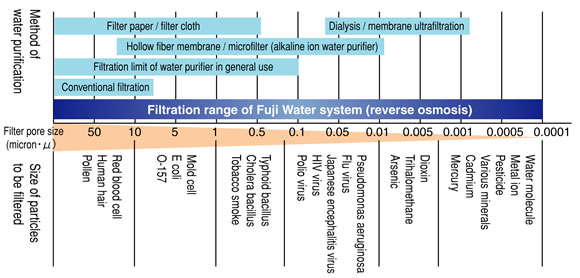|
|

What is Reverse Osmosis System (RO)?
Reverse Osmosis (RO) Water Filtration System was researched and developed to produce fresh water from seawater using government funding during the 1950's. By purifying water at the molecular level, even liquids like whisky, coffee, and urine can be purified into fresh water by the reverse osmosis process. This Reverse Osmosis System has been used by NASA, the U.S. military and the United Nations. On islands with little rainfall, large scale RO plants are utilized to secure water for daily use.
|
During natural osmosis, water flows from a less concentrated solution
through a semi-permeable membrane (Porous Membrane) to a more concentrated
saline solution until the concentration of water is equal on both sides.
As water passes through the membrane, the pressure on the less
concentrated solution drops. Simultaneously, the pressure of the more
concentrated solution rises until equilibrium is reached, halting the flow
of water through the membrane.
|
 |
|
Reverse osmosis uses
external pressure to reverse the natural osmotic flow. As pressure is
applied to the saline solution, water flows from the more concentrated
saline solution through a Porous Membrane to the less concentrated
solution.
|
 |
Reverse Osmosis results in the purest drinking water possible. The membrane is a dense material, allowing only molecules of water to be forced through the artificial thin film. The pre and post filters are effectively combined with the RO membrane to help purify the water and the incidence of poisonous substances in tap water is reduced drastically.

One of the characteristics of reverse osmosis is that despite the miniscule size of its membrane pores (0.0001 micron), the pores will not get clogged easily, because once water molecules are isolated, the remaining concentrated waste liquid with impurities cleans the membrane as it is being discharged. The 0.0001-micron ultra-microscopic pores thoroughly remove contaminants such as germs (pathogenic organisms), trihalomethane (carcinogen), pesticides, environmental hormones, and heavy metals.
▼Examples of removal rates:
| Parameter |
Rejection |
Parameter |
Rejection |
Parameter |
Rejection |
Parameter |
Rejection |
| Cadmium |
90-99% |
Chloride |
90-97% |
Nickel |
90-98% |
Antimony |
90-96% |
| Calcium |
90-97% |
Cyanide |
90-97% |
Zinc |
90-99% |
Beryllium |
90-98% |
| Copper |
90-99% |
Nitrate |
90-98% |
Silver |
90-98% |
Lead |
90-99% |
| Magnesium |
90-98% |
Trihalomethane |
100% |
Chrome |
90-99% |
Selenium |
85-95% |
| Sodium/Natrium |
85-95% |
Barium |
90-99% |
Sulfate |
90-98% |
Asbestos |
100% |
| Mercury |
90-98% |
Chlorine |
90-99% |
Iron |
90-97% |
Arsenic |
93-97% |

Return to the previous page |


